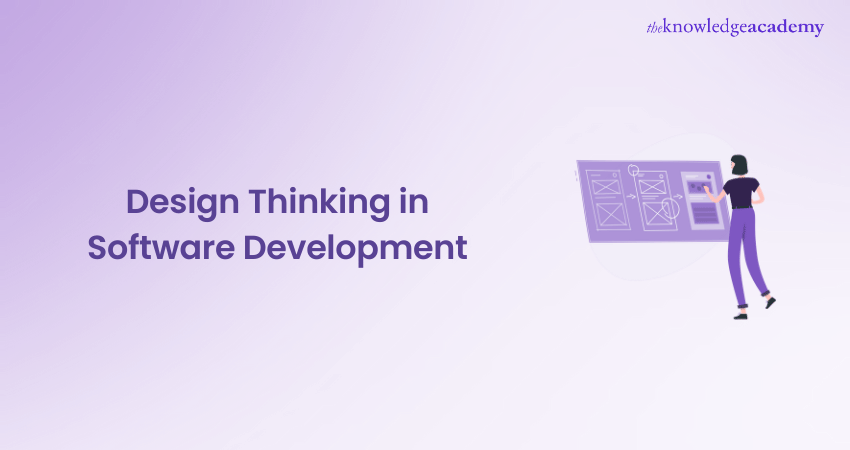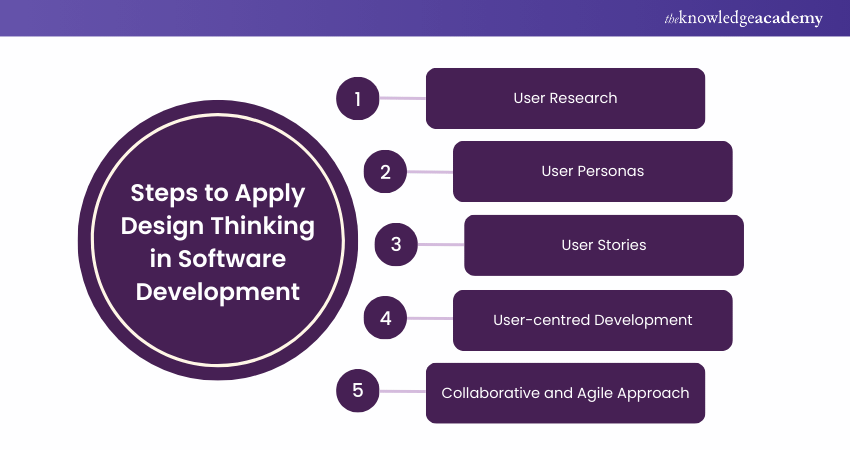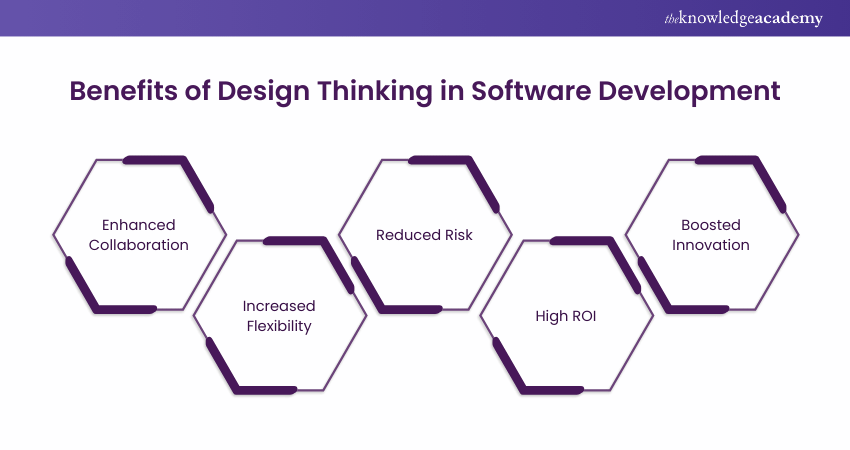We may not have the course you’re looking for. If you enquire or give us a call on 800600725 and speak to our training experts, we may still be able to help with your training requirements.
Training Outcomes Within Your Budget!
We ensure quality, budget-alignment, and timely delivery by our expert instructors.

Creating software is not just about writing lines of code or functionality; it is about crafting experiences that resonate with users profoundly. Design Thinking in Software Development integrates Design Thinking methodology derived from design disciplines into Software Development, revolutionising how software is conceptualised, designed, and executed.
Want to know how? Read this blog to explore the power of Design Thinking in Software Development. Learn how this approach can fuel creativity, enhance user experiences, and many more. Read now!
Table of Contents
1) What is Design Thinking in Software Development?
2) How is Design Thinking Relevant to Software Development?
3) Importance of Design Thinking in Software Development
4) How to Use Design Thinking in Software Development Life Cycle?
5) What are the Steps of Design Thinking in Software Development?
6) Benefits of Using Design Thinking in Software Development
7) Challenges of Using Design Thinking in Software Development
8) Conclusion
What is Design Thinking in Software Development?
Design Thinking in Software Development is a methodology that applies the principles of design to the process of creating software. It focuses on understanding the user's needs and challenges through empathy, which informs the entire development process.
The goal is to develop solutions that are technically viable, feasible, and desirable from a user perspective. The key components of Design Thinking in Software Development include Empathise, Define, Ideate, Prototype, Test and Implement.
How is Design Thinking Relevant to Software Development?
Design Thinking is extremely important in Software Development because it focuses on understanding and solving user requirements. This method focuses on the human element, encouraging developers to understand users' perspectives to create a functional and user-friendly end product.
Design Thinking, through its focus on the user's experience, aids in identifying authentic issues and producing innovative answers. It supports testing and feedback in cycles, enabling ongoing enhancements and polishing of the software. This approach improves the app's practicality and user-friendliness while encouraging teamwork and innovation among development groups.
In short, Design Thinking ensures that software solutions meet user expectations and effectively address their issues, resulting in increased satisfaction and engagement.
Importance of Design Thinking in Software Development
Design Thinking isn't just a process; it's a mindset that places empathy, creativity, and collaboration at its core. It's about approaching problems from the user's perspective, understanding their needs, and designing solutions that truly resonate with the user’s requirements.
Design Thinking offers a strategic advantage in an era where user expectations are high and competition is fierce. By integrating empathy, experimentation, and iteration, Design Thinking helps Developers create software that solves real problems, resonates emotionally, and drives user engagement. This is why understanding the Importance of Design Thinking is crucial.
How to Use Design Thinking in Software Development Life Cycle?
Now, let’s discuss how you can use Design Thinking in the Software Development Life Cycle step-by-step:

1) User Research
User research starts with conducting surveys and interviews to understand the requirements, habits, and pain points of users. It collects valuable data to facilitate the development process.
2) User Personas
Develop detailed user profiles using the collected research information. These personas depict various portions of your user base and assist in ensuring the development team stays focused on the requirements and preferences of the end-users.
3) User Stories
Create user stories that outline the features and functionalities from the user’s point of view. These stories help steer the development process by defining the user's goals and emphasising their significance.
4) User-centred Development
Use a user-oriented development approach by engaging users throughout the development cycle. Create test prototypes regularly and collect feedback to ensure the product fulfils the expectations of users.
5) Collaborative and Agile Approach
Foster a supportive Agile environment where various teams can work together seamlessly. An iterative development cycle might work best to quickly adapt to changes and gather user feedback, ensuring the product is user-friendly and innovative.
What are the Steps of Design Thinking in Software Development?
There are mainly five major steps involved in the process of Design Thinking that are discussed below:
1) Empathy
Empathy means being able to understand and feel what others are going through. In Design Thinking, the initial step involves looking at products and services from the perspective of users to understand what they need and want.
2) Define
This stage involves summarising and understanding the primary data. Start by defining your problem. Take a close look at what empathy has uncovered, considering users, their needs, and their viewpoints to shape your perspective. It's crucial to grasp your user’s identity fully The current user needs research results. Clarify and understand the issue, motivating the team to come up with solutions.
3) Ideate
Once you have solved a problem, it is important to encourage yourself to gather a wide range of ideas. It is important to have different views and perspectives. During exploration, every detail, no matter how small, should be supported. Picture your goal and think about how to reach it.
4) Prototype
Prototypes can be things you can touch, models, or plans, but their main job is to try out your idea and give an idea of how your final product will be. Because it's just a plan, making a prototype doesn't cost much and doesn't take much time. This early version shows how your product might look and feel based on the work you've done before.
5) Testing
The Design Thinking approach involves trying out different versions of a product and carefully checking them for problems. This ongoing testing and analysis help identify any issues and improve the design. The goal is to choose the best version of the product and make it as good as possible. This constant evaluation ensures that the final product is of the highest quality.
Learn about Design Thinking as a management tool for R&D projects with our Design Thinking For R&D Engineers Training – Register today!
Benefits of using Design Thinking in Software Development

Using Design Thinking Software Development offers several benefits that can significantly enhance both the process and the products that result from it. Here are some of the key advantages:
a) Improved User Experience: By focusing on user needs from the outset, Design Thinking ensures that the final product is user-centric. This leads to enhanced user satisfaction, as the software is tailored to meet real-world requirements and solve genuine problems.
b) Enhanced Collaboration: Design Thinking encourages collaboration across different teams, including Developers, Designers, and Business Stakeholders. This approach fosters creativity and ensures that all perspectives are considered, leading to more well-rounded solutions.
c) Increased Flexibility: The iterative nature of Design Thinking allows for flexibility in development. Teams can adapt to changes more effectively as they continually refine their approach based on user feedback. This agility is crucial in adapting to new insights and evolving market demands.
d) Reduced Risk: By prototyping and testing ideas before full-scale development, teams can identify potential issues early on. This not only saves time and resources but also reduces the risk of a product failing to meet user expectations after its release.
e) Higher Return on Investment (ROI): Products structured with the user in mind are more likely to be successful. A user-centric approach can lead to higher adoption rates, enhanced customer loyalty, and, ultimately, a better return on investment.
f) Boosted Innovation: Design Thinking challenges conventional problem-solving practices and encourages out-of-the-box thinking. This results in innovative solutions that might not have been discovered through traditional methods.
Learn to use creative and analytical for solving critical problems successfully with our Creative and Analytical Thinking Training –Join today!
Challenges of Using Design Thinking in Software Development
Applying Design Thinking in Software Development comes with several challenges:
1) Time and Resources
Design Thinking may require a significant amount of time and resources to be allocated effectively. Begin with modest tasks, gather insights from them, and implement any needed changes.
2) Gaining Stakeholder Support
It can be challenging to convince stakeholders, like managers and executives, who are not familiar with Design Thinking. Educate them about the advantages and ask for their help at the start of the process.
3) Cultural Shift
Embracing Design Thinking requires a change in culture within the organisation, shifting from focusing on features to focusing on users. In bigger companies, this change can be especially difficult.
4) Measuring Success
Assessing the effectiveness of Design Thinking projects may be difficult, but it's essential. Evaluate success by looking at customer results, such as satisfaction, and business results, such as increased revenue.
Conclusion
Applying Design Thinking to Software Development has revolutionised the process. Its principles, which focus on the user, its iterative methods, and the collaborative mindset, have fundamentally altered how software solutions are conceived and executed. By incorporating empathy, innovation, and adaptability, Developers can create software that not only satisfies user needs but also provides impactful experiences.
Gain knowledge of how Design Thinking, Lean, and Agile work together with our Design Thinking Course - Sign up now!
Frequently Asked Questions

Design Thinking involves using specific tools to help facilitate the design stages. These tools can include mind maps, empathy maps, journey maps, user personas, and project management software.

Design Thinking fosters innovation and creativity in Software Development by encouraging solutions deeply rooted in user needs and perspectives. Its iterative process of prototyping and testing allows for continuous refinement and exploration of creative ideas.

The Knowledge Academy takes global learning to new heights, offering over 30,000 online courses across 490+ locations in 220 countries. This expansive reach ensures accessibility and convenience for learners worldwide.
Alongside our diverse Online Course Catalogue, encompassing 17 major categories, we go the extra mile by providing a plethora of free educational Online Resources like News updates, blogs, videos, webinars, and interview questions. Tailoring learning experiences further, professionals can maximise value with customisable Course Bundles of TKA.

The Knowledge Academy’s Knowledge Pass, a prepaid voucher, adds another layer of flexibility, allowing course bookings over a 12-month period. Join us on a journey where education knows no bounds.

The Knowledge Academy offers various Leadership Training Courses, including Introduction to Supervising a Team, Women's Leadership Training etc. These courses cater to different skill levels, providing comprehensive insights into Innovative Thinking.
Dive into our Business Skills Blogs a trove of resources covering Leadership training. Whether you are a beginner or aiming to enhance your Leadership Skills, The Knowledge Academy's diverse courses and insightful blogs are your go-to source.
Upcoming Business Skills Resources Batches & Dates
Date
 Successful People Management and Team Leadership
Successful People Management and Team Leadership
Fri 6th Dec 2024
Fri 14th Feb 2025
Fri 16th May 2025
Fri 25th Jul 2025
Fri 29th Aug 2025
Fri 10th Oct 2025
Fri 28th Nov 2025
 Halloween sale! Upto 40% off - 95 Vouchers Left
Halloween sale! Upto 40% off - 95 Vouchers Left







 Top Rated Course
Top Rated Course



 If you wish to make any changes to your course, please
If you wish to make any changes to your course, please


